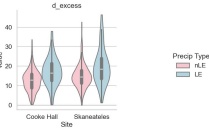Do Lake Effect Precipitation Events have a Unique Stable Isotope Fingerprint?: An Analysis of Isotope Data from Western New York
By: Aspen Marshall, University of Utah
Advisor: Elizabeth Thomas, PhD, Department of Earth Science, University at Buffalo
Advisor: Stuart Evans, PhD, Geography, University at Buffalo
Project Objectives
• See if lake effect events produce an unique stable isotope fingerprint that can be used to identify events that weren’t classified as lake effect but still came from the lake.
Data and Results
•Downloaded precipitation isotope data and created a list of LES days based on NWS archive.
• Discovered that lake effect events generally produce more depleted values of the stable isotopes of hydrogen and oxygen and higher values of d-excess.
Significance
• This data can be fed into a moisture recycling model to see how much the lake has contributed to precipitation over the past 11 years.
• Possible to use paleoclimatological records to see how lake effect has changed in the past.
Publication or Conference
Not at this time.
------------------------------------------------------------------------------------------------
Center for Geological and Climate Hazards
Interdisciplinary Research Experience for Undergraduates in Atmospheric and Geological Hazards

Lake effect (LE) events have a higher value for d-excess than non-lake effect events (nLE). In addition, values are higher at Skaneateles than Cooke Hall. This is for winter months only to avoid seasonality.